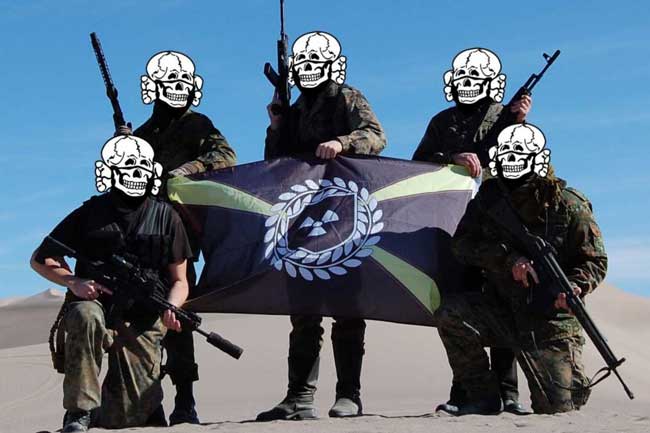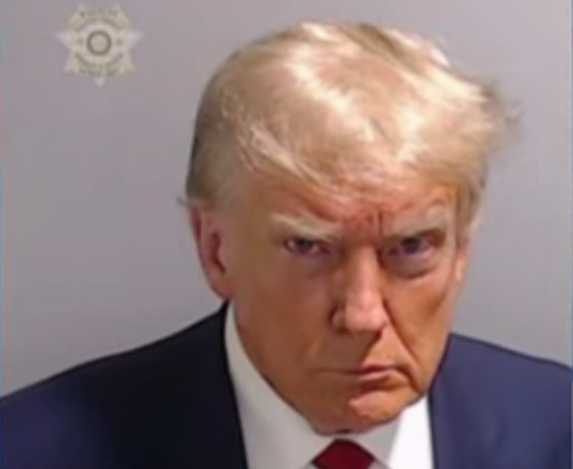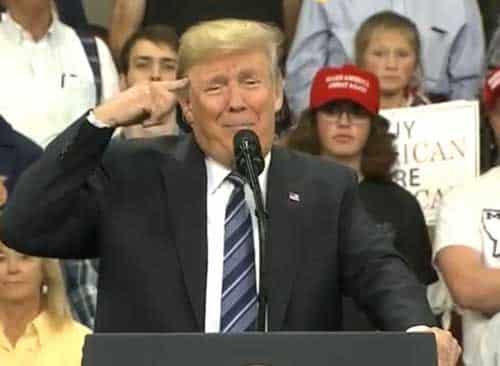WASHINGTON — Recent instances in which former U.S. President Donald Trump appears to embrace the QAnon conspiracy theory are raising concern among some lawmakers, veteran law enforcement officials and cult experts.
Trump shared a picture of himself wearing a Q lapel pin, overlaid with the QAnon phrases “The Storm is Coming” and “WWG1WGA,” (an acronym for “Where We Go One, We Go All) on his Truth Social account September 12.
Trump has amplified at least 50 separate QAnon-promoting accounts since joining and actively using his Truth Social online platform, according to Alex Kaplan, senior researcher at Media Matters for America, a left-wing media watchdog.
“Just in case it wasn’t abundantly CLEAR at this point, President Trump himself is making it UNDENIABLE that he is 100% aligning with the Q operation,” John Sabal, an organizer of QAnon-focused conferences, posted on his Telegram channel. Sabal has previously stated the U.S. military is obligated to remove President Joe Biden from office, who the conspiracy theorist termed a “rouge actor.”
QAnon debuted five years ago on a fringe online platform. Cryptic and false statements were repeatedly posted by an anonymous commentator known as “Q,” who claimed to be a U.S. government insider. Many followers of the movement, based on those postings, came to believe Trump is engaged in a secret war against “deep state” enemies, including former Democratic Party presidential candidate Hillary Clinton, whom Trump defeated in 2016. According to the bizarre conspiracy, Clinton and other Democrats are part of a cabal of devil worshippers who abduct children to abuse and even eat.
The former president, while not openly parroting that belief, does frequently espouse without credible evidence other related conspiracy theories, including that the 2020 presidential election results were altered to deny him a second term.
“A vile group of corrupt, power-hungry globalists, socialists and liberal extremists in Washington has been waging war on the hardworking people of Ohio,” Trump said at a rally September 17 in Youngstown. “Our biggest threat remains the sick, sinister and evil people from within our country.”
A melody played at the Ohio event that was nearly identical to a QAnon anthem titled “Wwg1wga” (an acronym for “where we go one, we go all”). The same song was previously heard at a Trump rally in neighboring Pennsylvania and in a recent video linked to the former president.
As the music played during the Youngstown event, many in the audience pointed an index finger into the air, which some observers say denote the “one” in the QAnon slogan. Some online commentators, including Walter Shaub, a former director of the U.S. Office of Government Ethics, compared the imagery to fascist rallies of the 1930s and 1940s.
Don’t be disarmed by how goofy Trump followers are. Mussolini was a buffoon. Hitler was ridiculous. Out of context, even their uniforms were like something out of a campy broadway spoof. Duterte and Bolsonaro are total clowns. Fascism is inherently dopey—until the killing starts.
— Walter Shaub (@waltshaub) September 18, 2022
Others on social media contended the gesture, which had not been previously seen at Trump rallies, was too vague to definitively link to the QAnon movement, noting it might have been a reference to the “America First” theme Trump has invoked since running for president in 2015. The salute is also identified with the nonpolitical Salvation Army, a Christian movement founded in the mid-19th century.
“The fake news, in a pathetic attempt to create controversy and divide America, is brewing up another conspiracy about a royalty-free song from a popular audio library platform,” Taylor Budowich, a spokesman for Trump’s post-presidential office, told VOA in response to a query attempting to clarify questions about the music and the salute at the rally.
‘Last gasp of a dying cult’
The Ohio event “was a QAnon fest,” according to Barbara Comstock, a former Republican member of Congress. On CNN, she noted the rally’s “strange QAnon music” and the obsequent gesture while discounting the significance of Trump’s apparent embrace of the controversial movement.
Noting that the event was lightly attended compared to the former president’s previous rallies, Comstock called the rally “the last gasp of a dying cult.”
Frank Figliuzzi, a former assistant director of the Federal Bureau of Investigation, contends that Trump is embracing the QAnon movement in desperation, and the former president is aware of how dangerous it is.
“Not only do I think he knows it, but I think that’s what attracts him to this. It’s like a moth to the flame,” Figliuzzi said on MSNBC.
With Trump facing trouble on multiple legal fronts, his attraction to QAnon can be compared “to the last act of a desperate man,” Figliuzzi added.
The former FBI official also expressed concern that Trump, perceived as the cult’s political leader, will in his desperation advocate violence.
“The members take a step up and force the ending — whatever that could be,” Figliuzzi said. “That’s what concerns me, and we’ve learned from January 6 it only takes a small number of people to do that.”
On January 6, 2021, thousands of Trump supporters stormed the grounds of the U.S. Capitol in an attempt to prevent lawmakers from conducting the electoral vote count formalizing Joe Biden’s victory in the presidential election. More than 900 people have been arrested and charged with crimes in connection with the attack.
As president in 2020, Trump said he did not know much about QAnon, adding he could not disprove its conspiracy theory.
“If I can help save the world from problems, I’m willing to do it,” Trump replied when asked if he, in line with the QAnon belief, was saving the country from a satanic cult of child sex traffickers.
According to a study released in February, about 16% of Americans are QAnon believers, while this year about 80 candidates who believe in QAnon have been on the ballot for political offices in 26 states, including the Republican nominee for governor in Maryland, according to online news site Grid News.
QAnon is “a delusional and armed terrorist movement,” according to Laurence Tribe, professor emeritus of the Harvard University Law School, who on Twitter called Trump’s overt embrace of it “a terrifying sign that he is desperate, and realizing he will be indicted, is preparing to wage open war on the United States of America. It’s a testament to our tolerance that he isn’t under arrest.”
Trump is “realizing the populace is getting tired of him. Many Republicans see him as more dangerous, and he is escalating to violence,” said Steven Hassan, a licensed mental health counselor who predicted in his 2019 book The Cult of Trump: A Leading Cult Expert Explains How the President Uses Mind Control that Trump would resort to calls for violence if he was not re-elected in 2020.
Hassan told VOA he perceives Trump as a figurehead whom leaders of fringe groups attempt to manipulate rather than directing any conspiracy movements, QAnon being prominent.
QAnon was specifically named by the FBI in a 2019 intelligence bulletin as among the fringe political movements very likely to motivate some domestic extremists to commit criminal and sometimes violent activity.
Since then, QAnon has been tied to violent incidents.
‘American disease’
There is a sordid history of conspiracy theories and prejudice to influence the American electorate — including anti-immigrant and anti-Catholic movements.
“Conspiracy thinking is an American disease. It’s in our bloodstream,” according to Richard Shenkman, author of the book Political Animals: How Our Stone-Age Brain Gets in the Way of Smart Politics.
“It’s been there from the beginning. Even the Founding Fathers were susceptible to conspiracy thinking. They believed that they were the victims of a European conspiracy, particularly in England, to keep them down,” Shenkman said.
Awful Disclosures, an anti-Catholic book, was widely read in 19th-century America, even though it was quickly exposed as a hoax. In the book, a Canadian nun recounted tales of perverse priests and barbaric penances forced on young captive women.
A Catholic was not elected president of the United States until John Kennedy defeated Richard Nixon in the 1960 election.
Conspiracy theories often target religions, races and other minority or vulnerable groups as scapegoats for economic trouble in a society.
“Most American presidents have just come up to the edge of conspiracy thinking and seeding the public square with nonsense ideas, but they were very careful not to get the mud on themselves,” Shenkman told VOA. “The difference between Donald Trump and all the other presidents we’ve had is his willingness to cross that line and just do the dirty work himself. It’s phenomenal that he just seems to have no compunction about it.”
Even if Trump and QAnon fade, conspiracy theories are unlikely to disappear from American politics, Shenkman said.
“During periods of disquiet, like our current period, people find [conspiracy theories] appealing because they want easy answers” to complex economic and social issues. “We want certitude, and conspiracy theories are beautiful in that way. They give you a nice, simple answer,” he said.
[content id=”52927″][content id=”79272″]








